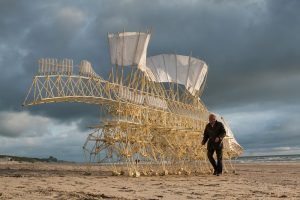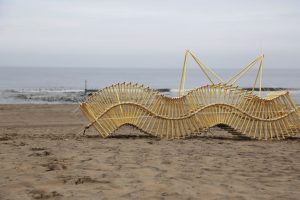There’s always been a close connection between art and science. For example everyone is aware of the fact that Leonardo de Vinci was as interested in inventing things as he was in his paintings. Many well-known artists have also been architects designing magnificent buildings while many of the world’s great engineering feats; bridges, skyscrapers and the like are also considered works of art.
So it isn’t really all that surprising that Dutch artist Theo Jansen studied physics as a student at Delft University of Technology. Born in Scheveningen in the Netherlands on March 14th, 1948, Jansen was from his childhood interested in both science and art. The Image below is of Theo Jansen.

Jansen’s work has consisted of a large number of what are known as kinetic sculptures, literally sculptures that move. His first attempt came in 1979 when he built and flew a four-meter wide flying saucer made from PVC pipe and filled with helium. As you might guess the artwork was mistaken for the real thing by many people and caused quite a stir.
Then in the mid-80s Jansen developed a ‘Painting Machine’ which employed a photoelectric cell to turn ON or OFF a spray can of paint allowing the machine to paint the outlines of people as well as other objects.
Jansen’s chief fame however has come from his design and construction of what he calls Strandbeesten (Dutch for Beach Beasts) starting in the 1990s. Usually powered by the wind the Strandbeesten are large constructions that walk across the sand much like a living creature, indeed Jansen himself describes his creations as artificial life. The image below shows one of Jansen’s Strandbeesten.

All of the Strandbeesten are constructed around a basic mechanism that converts the rotation of an axis into a walking motion of six or more legs using triangles and linkages made of sections of PVC. Although still made from simple materials like PVC, wood and fabric for the sails, Jansen’s creatures have evolved a great deal over the last twenty-five years. Some are now able to actually detect the ocean water when they step in it and alter their course to avoid going in any deeper! Another version can detect a storm approaching and anchor themselves to the ground to prevent any wind damage.


In the future Jansen hopes to design and construct entire herds of Strandbeesten to wander the Dutch coastline. Also NASA is considering using Jansen’s basic motion mechanism in a design for a possible Venus lander. The environmental conditions on Venus are so harsh that conventional motors and wheels won’t work so Jansen’s approach might be a possible alternative.
I’ve included several images of Jansen’s creations in this post but to fully appreciate the Strandbeesten you must see them in motion. The links below will take you to some youtube videos that show better than I can ever say in words just how weirdly wonderful they are.
https://www.youtube.com/watch?v=KsqlnGMzMD4
https://www.youtube.com/watch?v=On8v-Wr3XxU
Theo Jansen is just another example of how art and science can not only compliment each other but actually merge together to form some of humanity’s most beautiful creations.
